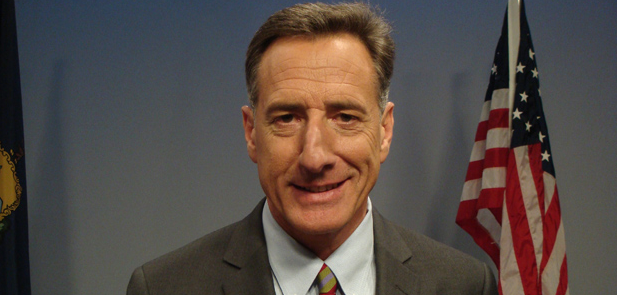By Jon Street | Watchdog.org
MONTPELIER — Gov. Peter Shumlin wants a 5-percent hike in the upcoming budget while Vermont’s economy is growing at just 1.2 percent annually.
The governor’s proposal for fiscal year 2014-15 came Wednesday during a joint-session of the Vermont Legislature, during which he delivered his annual budget address.
Shumlin said his budget proposal not only closes the state’s $70 million budget gap but “invests in areas critical to our most vulnerable and to our future job growth, while rejecting broad-based tax increases on hard working Vermonters.”
But his proposal has left some inside and outside the Statehouse scratching their heads.
Tom Pelham, who served in three governor-appointed positions under three administrations, including as commissioner of finance and management under former Gov. Howard Dean, said Shumlin’s proposed spending levels are “more of the same” because the spending levels are not proportional to the rate at which the state’s economy is actually growing.
The U.S. Labor Department’s Bureau of Economic Analysis reported the rate of increase in Vermont’s Gross Domestic Product from 2011-2012 was 1.2 percent, making it one of 20 states and the District of Columbia with GDP growth rates at or below 1.5 percent in 2012. That’s well below the national average growth rate of 2.2 percent the same year.
Nonetheless, Shumlin’s proposal includes the 5-percent spending increase without any cuts or tax hikes. Compare that with the much lower rate at which the economy is actually growing, and Pelham says the budget gap just gets “wider and wider.”
“I think Gov. Shumlin’s budget is substantially out of sync with what’s going on with the overall economy,” Pelham told Vermont Watchdog.
Even one member of the Shumlin’s own party, Sen. Richard Mazza, D-Chittenden, stopped short of embracing the plan.
Responding to whether he thinks the economic growth rate in Vermont is equal to the 5-percent increase in proposed spending, Mazza said, “Financial forecasters look ahead. You hope they come within it. But again, it could be over. It could be under. That’s the game you play and the chance you take. There’s nobody who can really tell you what’s going to happen.”
Mazza questioned whether Shumlin may have been “too generous” by proposing a 5-percent increase while seeming hesitant to believe 11,000 jobs have been added since the economic recovery began in 2009.
“(Shumlin) said there (are) 11,000 new jobs. I don’t know where they got that figure but we’re assuming there are 11,000 new jobs, which would be great. But we’re still looking at how he came up with that figure,” Mazza said.
Jack Hoffmann, an analyst for the Vermont-based nonprofit Public Assets Institute, said “Understanding the details about exactly where the governor plans to make investments and where the money will come from will require deeper analysis.”
At the same time, the Public Assets Institute suggested Shumlin deserves credit for wanting to make the kinds of investments that have been shown to provide good returns — infrastructure, education, health care and early childhood development.
Indeed, Shumlin proposed considerable increases to each of these areas and several others.
Among the highlights of Shumlin’s sought-after funding increases are $33 million for transportation and infrastructure, $4.3 million in new initiatives to fight poverty, $9.8 million for a 2-percent increase to Medicaid reimbursement, $19.3 million to implement more community-based mental health programs, $6.8 million for teachers’ pensions, $2.5 million for retired teachers’ health insurance, $840,000 for a 2-percent increase in funding for higher education, and $500,000 for downtown tax credits.
That amounts to $77,040,000 in total new spending, about $7 million more than the state’s budget deficit.



